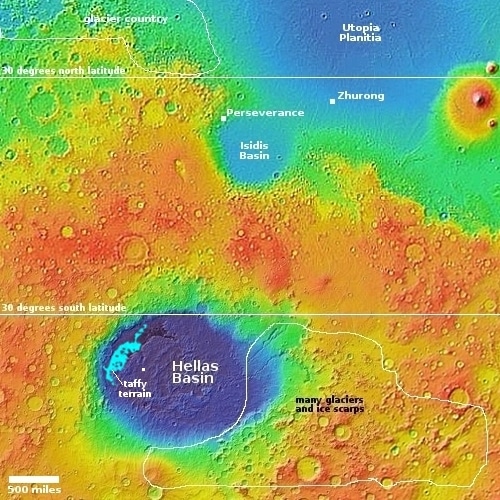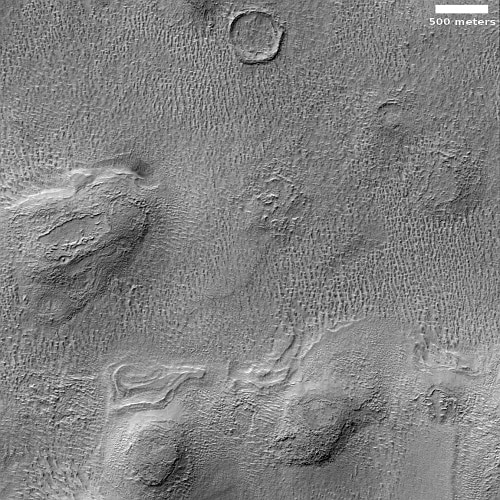The strange terrain in the basement of Mars
I’ve posted numerous cool images about the weird and alien terrain found routinely in what is Mars’ death valley, Hellas Basin. Today is no different. The picture to the right, rotated, cropped, reduced, and sharpened to post here, was taken on February 23, 2023 to fill a gap in the schedule of the high resolution camera on Mars Reconnaissance Orbiter (MRO). Thus, it isn’t linked to any particular research, and its target was chosen by the camera science team almost at random.
What it shows is a strangely striated plain interspersed with rounded mesas and partly buried craters. The shape of the striations suggests that they were formed from wind blowing consistently from the north. This hypothesis is reinforced by the material that seems piled up at the base of the two bottom mesas, as if it was blown there.
Is ice or lava however?

The white dot in the northwest quadrant of Hellas Basin of the overview map to the right marks the location. The latitude is 41 degrees south, placing it far enough from the equator that near-surface ice could very well be present. The low elevation however seems to make this less likely, based on images so far gathered inside Hellas.
Is it lava? The nearby taffy terrain is generally thought to be the hardened flow of vicious material, most likely lava. This picture could thus be showing us a flood lava plain, with the surface striations caused by erosion or wind-blown dust and volcanic ash.
Or possibly we are looking alien geology formed by a combination of lava and glacial processes on a planet with one third the gravity of Earth and climate almost always below freezing.
On Christmas Eve 1968 three Americans became the first humans to visit another world. What they did to celebrate was unexpected and profound, and will be remembered throughout all human history. Genesis: the Story of Apollo 8, Robert Zimmerman's classic history of humanity's first journey to another world, tells that story, and it is now available as both an ebook and an audiobook, both with a foreword by Valerie Anders and a new introduction by Robert Zimmerman.
The print edition can be purchased at Amazon or from any other book seller. If you want an autographed copy the price is $60 for the hardback and $45 for the paperback, plus $8 shipping for each. Go here for purchasing details. The ebook is available everywhere for $5.99 (before discount) at amazon, or direct from my ebook publisher, ebookit. If you buy it from ebookit you don't support the big tech companies and the author gets a bigger cut much sooner.
The audiobook is also available at all these vendors, and is also free with a 30-day trial membership to Audible.
"Not simply about one mission, [Genesis] is also the history of America's quest for the moon... Zimmerman has done a masterful job of tying disparate events together into a solid account of one of America's greatest human triumphs."--San Antonio Express-News
I’ve posted numerous cool images about the weird and alien terrain found routinely in what is Mars’ death valley, Hellas Basin. Today is no different. The picture to the right, rotated, cropped, reduced, and sharpened to post here, was taken on February 23, 2023 to fill a gap in the schedule of the high resolution camera on Mars Reconnaissance Orbiter (MRO). Thus, it isn’t linked to any particular research, and its target was chosen by the camera science team almost at random.
What it shows is a strangely striated plain interspersed with rounded mesas and partly buried craters. The shape of the striations suggests that they were formed from wind blowing consistently from the north. This hypothesis is reinforced by the material that seems piled up at the base of the two bottom mesas, as if it was blown there.
Is ice or lava however?

The white dot in the northwest quadrant of Hellas Basin of the overview map to the right marks the location. The latitude is 41 degrees south, placing it far enough from the equator that near-surface ice could very well be present. The low elevation however seems to make this less likely, based on images so far gathered inside Hellas.
Is it lava? The nearby taffy terrain is generally thought to be the hardened flow of vicious material, most likely lava. This picture could thus be showing us a flood lava plain, with the surface striations caused by erosion or wind-blown dust and volcanic ash.
Or possibly we are looking alien geology formed by a combination of lava and glacial processes on a planet with one third the gravity of Earth and climate almost always below freezing.
On Christmas Eve 1968 three Americans became the first humans to visit another world. What they did to celebrate was unexpected and profound, and will be remembered throughout all human history. Genesis: the Story of Apollo 8, Robert Zimmerman's classic history of humanity's first journey to another world, tells that story, and it is now available as both an ebook and an audiobook, both with a foreword by Valerie Anders and a new introduction by Robert Zimmerman.
The print edition can be purchased at Amazon or from any other book seller. If you want an autographed copy the price is $60 for the hardback and $45 for the paperback, plus $8 shipping for each. Go here for purchasing details. The ebook is available everywhere for $5.99 (before discount) at amazon, or direct from my ebook publisher, ebookit. If you buy it from ebookit you don't support the big tech companies and the author gets a bigger cut much sooner.
The audiobook is also available at all these vendors, and is also free with a 30-day trial membership to Audible.
"Not simply about one mission, [Genesis] is also the history of America's quest for the moon... Zimmerman has done a masterful job of tying disparate events together into a solid account of one of America's greatest human triumphs."--San Antonio Express-News



Again, these pictures remind me so much of snow and ice formations.
In particular, if you zoom in very closely to the area just below the extremely large mound (cropped out of the smaller picture in the post) you’ll see what appear to be large boulders that have trailing and tapering structures “behind” them. Each one of these points towards the bottom of the picture, to the south.
Every winter on a high plateau here in Wyoming the snow melts off in the sun. Because we’re at around 45° North latitude the shadows of each individual sagebrush are to the North…and going through that area is funny because each sagebrush has its own little patch of snow behind it pointing directly north.
Here in the Southern Martian hemisphere, is it possible that the same thing is happening? That these are mounds of shadow-sheltered ice (water or CO2) that would otherwise have melted or sublimated away?
Just a thought.
Blackwing1: Your thoughts are good, describing processes seen on Mars. For example, in the high latitudes (above 60 degrees) on Mars a mantle of CO2 settles on everything in winter, only to sublimate away when spring arrives. This location however is at 41 degrees, and it is the Martian fall when this picture was taken.
It is possible that we are seeing ice behind small mounds, but I can’t imagine what would line those mounds up so precisely in these parallel lines, equidistant from each other in all directions.